Global and China Automotive Smart Antenna Research Report, 2022-2023
Smart antenna research: the integration of automotive antennas and intelligent connected terminals tends to accelerate.
The development trend of automotive antennas: tend to be intelligent, diversified and integrated.
Automotive antennas have entered an era of intelligence. OEMs place a higher premium on the application of antenna functions amid V2X and smartphone integration, thereby facilitating the intelligent, diversified, and integrated development of automotive antennas. As new technologies such as 5G and MIMO find application, antenna manufacturers also endeavor to research anti-jamming and all-in-one antenna technologies, that is, ensuring that multiple automotive antennas of different types work normally and independently in multi-antenna integration.
Main development trends of automotive antennas:
 Intelligent: integrated with intelligent connected terminals, and applied to ADAS and V2X scenarios, e.g., Continental’s shark fin antenna;
Intelligent: integrated with intelligent connected terminals, and applied to ADAS and V2X scenarios, e.g., Continental’s shark fin antenna;
 Integrated: more common in high-end vehicle models, adopt hidden antenna design, and highlight the reinforced anti-jamming performance of different types of antennas, e.g., SPEED's all-in-one antenna;
Integrated: more common in high-end vehicle models, adopt hidden antenna design, and highlight the reinforced anti-jamming performance of different types of antennas, e.g., SPEED's all-in-one antenna;
 Diversified: bring antenna functions into full play in different scenarios, and use all-in-one antenna technology, e.g., Glead’s multi-mode antenna and YOKOWO’s combined shark fin antenna.
Diversified: bring antenna functions into full play in different scenarios, and use all-in-one antenna technology, e.g., Glead’s multi-mode antenna and YOKOWO’s combined shark fin antenna.
Foreign first-tier automotive antenna manufacturers are led by Continental, TE Connectivity, Harada Industry and Ficosa. They use all-in-one antenna technology to integrate AM/FM/cellular/GNSS antennas into the shark fin and combine them with intelligent connected terminals. For example, the shark fin antenna provided by Continental for OEMs like Volvo and BMW is integrated with T-Box and uses smart antenna modules to simplify the antenna layout of the car body; Bosch has also developed a smart antenna akin to the T-Box-integrated smart antenna.
Chinese automotive antenna manufacturers include Harxon, Desay SV, SPEED, Sunway Communication, Lan-You Technology and Neusoft Group. They also master all-in-one antenna development technology, and have the ability to develop smart antennas that can be integrated with intelligent connected terminals. One example is Neusoft Group’s C-V2X smart antenna having been mounted on Hongqi E-HS9.
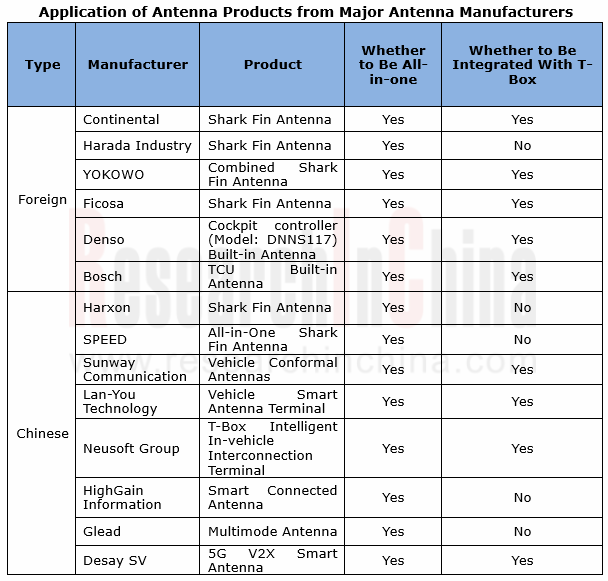
Continental Shark Fin Antenna
Continental's new-generation T-Box for Mercedes-Benz, Volvo and PSA is integrated with the shark fin antenna Continental calls BSRF. The figure below is the structure drawing of BSRF: from left to right is BroadR-Reach Ethernet connection, 20-pin master audio connection, and backup battery connection. There is also an FM connection on the other side.
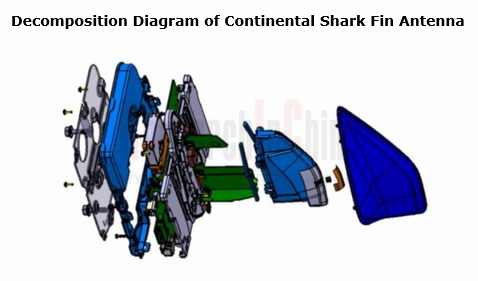
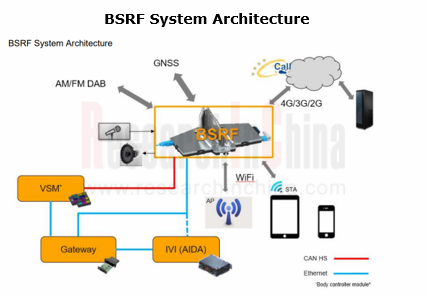
Continental has launched a 5G V2X shark fin antenna as early as 2020. This antenna integrates 5G antenna, V2X antenna (C-V2X and DSRC), and GPS L1/L2 dual-band navigation antenna, enabling rapid transmission of a mass of data.
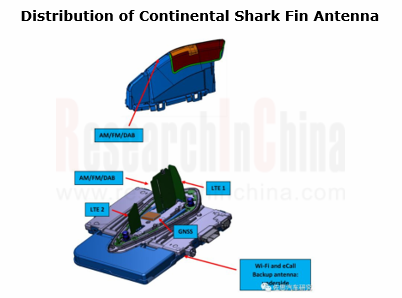
YOKOWO Antenna
YOKOWO's vehicle antenna products include:
- AM/FM antenna (frequency range: 0.5-110MHz);
- High-precision positioning antenna for L1/L2 and L1/L5;
- Shark fin antenna (customized according to vehicle models);
- GPS antenna
- V2X antenna
Where YOKOWO's vehicle antenna products are installed on a car: (1) right on the roof; (2) rear of the roof (active); (3) glass sunroof; (4) classic exterior positions, e.g., the front of the car.
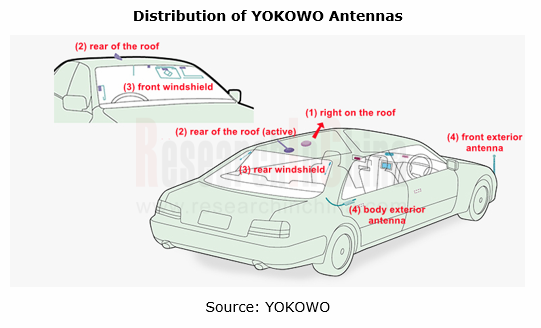
Harxon
Harxon, a subsidiary of BDStar Navigation, offers 6 types of vehicle antennas, among which shark fin antenna is applicable to L3 /L4 autonomous driving.
In June 2022, Harxon cooperated with Neta Auto on several new model projects, providing intelligent connected vehicle antenna products for Hozon New Energy Automobile. In September 2022, Harxon joined hands with Zhito Technology on application of high-precision positioning and intelligent connection and communication technologies in Zhito’s L3 intelligent heavy trucks, including high-precision positioning service, integrated navigation, 5G communication, and V2X communication.
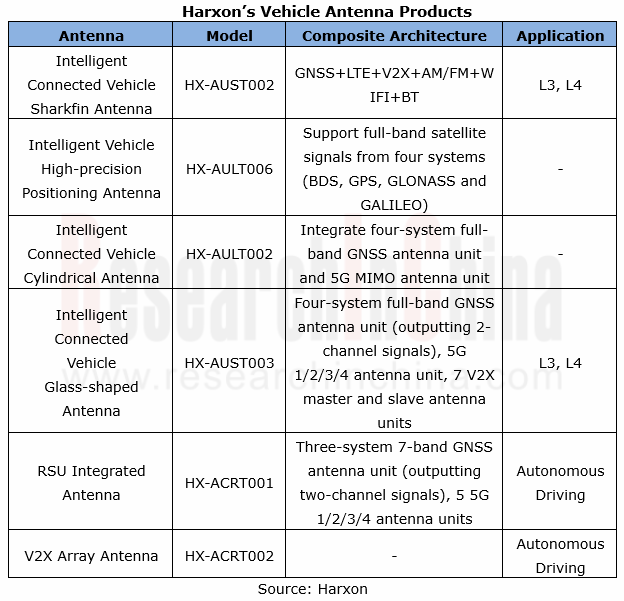
Conventional automakers: shark fin becomes the main carrier for vehicle smart antennas.
Shark fin antenna was developed by BMW in 2001 and initially applied to E65/E66 in the fourth-generation BMW 7 Series. BMW then developed the second-generation shark fin antenna that directly connected the connected driving telematics module and the shark fin base and added a dedicated communication antenna for connected driving. It was used in the new BMW 7 Series models.
At present, the mainstream models in the 1 to 7 Series all use shark fin antennas, and only one model in the I Series and M Series each does not use. BMW's shark fin antenna can integrate GSM antenna, GPS antenna, TCU emergency rescue antenna and DAB antenna (the integrated GSM antenna is used to amplify the phone signals in the car; the integrated GPS antenna is used for vehicle navigation and positioning; the integrated connected driving antenna is used for telecommunication). Its AM/FM antenna is installed at the rear windshield.
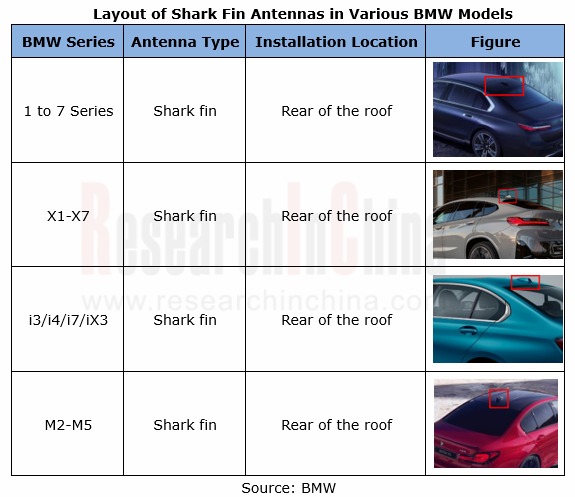
Auto brands with high market shares, including Volkswagen, Toyota, Audi, Honda, Buick and Changan, also favor shark fin antennas when choosing antenna solutions, and install them at the rear of the roof.
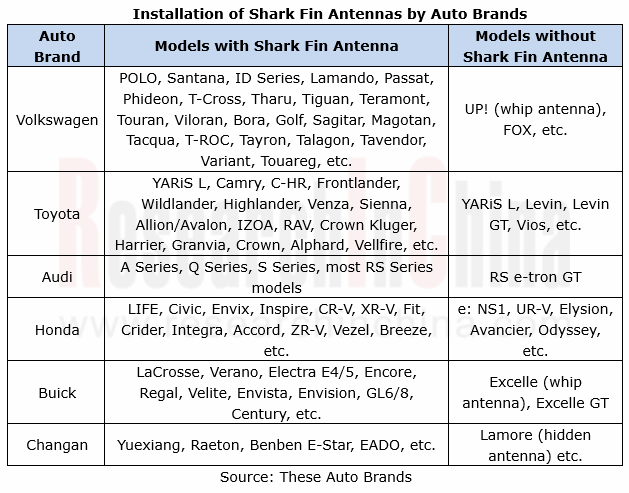
Emerging carmakers: underline differentiation of smart antenna solutions.
Unlike conventional automakers using shark fin antennas, emerging carmakers prefer differentiation when selecting smart antennas. Among them, NIO chooses a camera-equipped shark-fin antenna structure as the smart antenna solution for its new models; Xpeng Motors and Li Auto integrate smart antennas into the roof rack and spoiler, respectively, for the latest models to make them look more sleek-framed; Tesla chooses to integrate the antenna module into the crossbar of the car body to further simplify the antenna layout.
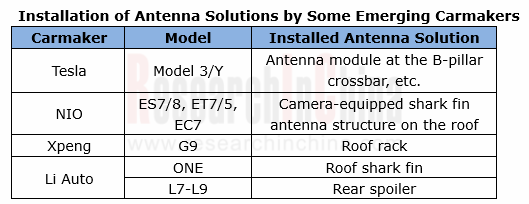
New Tesla Model 3/Y has placed WiFi and 4G LTE antennas in crossbar in the middle of the sunroof above the B-pillar; the GPS antenna module of Model 3 is located above the interior rearview mirror in the same space as the camera module.
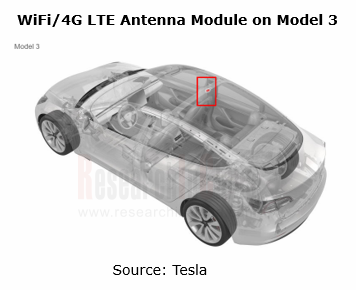
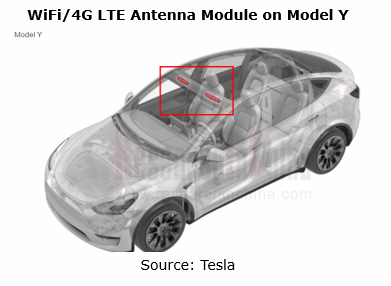
NIO ES7/8, ET7/5, and EC7 are all equipped with a shark fin antenna structure (with a camera) at the rear of the roof and above the trunk. For example, the shark fin antenna of ES7/8 integrates a rearview driving assistance camera and 5G communication module; the shark fin antenna structure of ET7/5 highlights camera design in appearance.
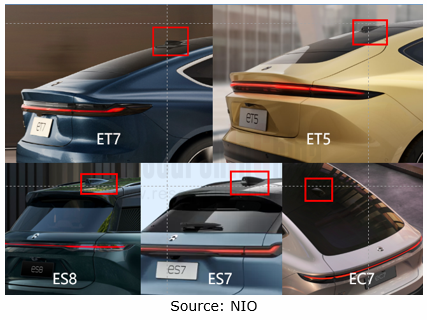
Xpeng G9 uses a hidden 5G antenna and integrates it into the roof rack. This antenna can support high-speed data transmission for the car.
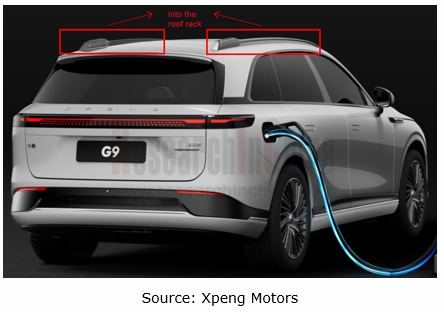
Li Auto ONE packs a shark fin antenna, while the automaker switches to a spoiler-integrated antenna for models from L7 to L9. The antenna accessories for the L7 to L9 models are all provided by SPEED, including 5G antenna, high-precision positioning antenna and radio amplifier. Li Auto L9's Bluetooth antenna can sense both horizontal/vertical coordinates and height of the user's smartphone.
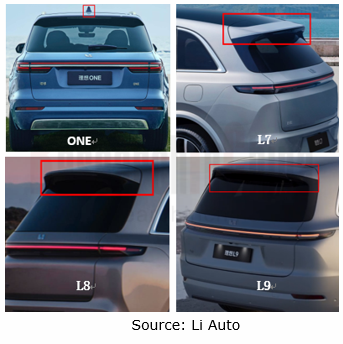
OEMs and Tier 1 Suppliers' Cost Reduction and Efficiency Enhancement Strategy Analysis Report, 2025
ResearchInChina released the "OEMs and Tier 1 Suppliers' Cost Reduction and Efficiency Enhancement Strategy Analysis Report, 2025", summarizing hundreds of cost reduction strategies to provide referen...
Automotive Fixed Panoramic Sunroof and Smart Roof Research Report, 2025
With the intelligent application of car roofs as the core, this report systematically sorts out a series of new products such as fixed panoramic sunroof/openable sunroof, ceiling screen, roof ambient ...
Automotive-Grade Power Semiconductor and Module (SiC, GaN) Industry Research Report, 2025
SiC/GaN Research: Sales volume of 800V+ architecture-based vehicles will increase more than 10 times, and hybrid carbon (SiC+IGBT) power modules are rapidly being deployed in vehicles.
Sales volume o...
Cockpit Agent Engineering Research Report, 2025
Cockpit Agent Engineering Research: Breakthrough from Digital AI to Physical AI
Cockpit Agent Engineering Research Report, 2025 starts with the status quo of cockpit agents, summarizes the technical ...
Prospective Study on L3 Intelligent Driving Technology of OEMs and Tier 1 Suppliers, 2025
L3 Research: The Window of Opportunity Has Arrived - Eight Trends in L3 Layout of OEMs and Tier 1 Suppliers
Through in-depth research on 15 OEMs (including 8 Chinese and 7 foreign OEMs) and 9 Tier 1 ...
China Commercial Vehicle IoV and Intelligent Cockpit Industry Research Report 2025
Commercial Vehicle IoV and Cockpit Research: The Third Wave of Passenger Car/Commercial Vehicle Technology Integration Arrives, and T-Box Integrates e-Call and 15.6-inch for Vehicles
I. The third wav...
Intelligent Vehicle Electronic and Electrical Architecture (EEA) and Technology Supply Chain Construction Strategy Research Report, 2025
E/E Architecture Research: 24 OEMs Deploy Innovative Products from Platform Architectures to Technical Selling Points
According to statistics from ResearchInChina, 802,000 passenger cars with domain...
Research Report on Intelligent Vehicle Cross-Domain Integration Strategies and Innovative Function Scenarios, 2025
Cross-Domain Integration Strategy Research: Automakers' Competition Extends to Cross-Domain Innovative Function Scenarios such as Cockpit-Driving, Powertrain, and Chassis
Cross-domain integration of ...
China Autonomous Driving Data Closed Loop Research Report, 2025
Data Closed-Loop Research: Synthetic Data Accounts for Over 50%, Full-process Automated Toolchain Gradually Implemented
Key Points:From 2023 to 2025, the proportion of synthetic data increased from 2...
Automotive Glass and Smart Glass Research Report, 2025
Automotive Glass Report: Dimmable Glass Offers Active Mode, Penetration Rate Expected to Reach 10% by 2030
ResearchInChina releases the Automotive Glass and Smart Glass Research Report, 2025. This r...
Passenger Car Brake-by-Wire (BBW) Research Report, 2025
Brake-by-Wire: EHB to Be Installed in 12 Million Vehicles in 2025
1. EHB Have Been Installed in over 10 Million Vehicles, A Figure to Hit 12 Million in 2025.
In 2024, the brake-by-wire, Electro-Hydr...
Autonomous Driving Domain Controller and Central Computing Unit (CCU) Industry Report, 2025
Research on Autonomous Driving Domain Controllers: Monthly Penetration Rate Exceeded 30% for the First Time, and 700T+ Ultrahigh-compute Domain Controller Products Are Rapidly Installed in Vehicles
L...
China Automotive Lighting and Ambient Lighting System Research Report, 2025
Automotive Lighting System Research: In 2025H1, Autonomous Driving System (ADS) Marker Lamps Saw an 11-Fold Year-on-Year Growth and the Installation Rate of Automotive LED Lighting Approached 90...
Ecological Domain and Automotive Hardware Expansion Research Report, 2025
ResearchInChina has released the Ecological Domain and Automotive Hardware Expansion Research Report, 2025, which delves into the application of various automotive extended hardware, supplier ecologic...
Automotive Seating Innovation Technology Trend Research Report, 2025
Automotive Seating Research: With Popularization of Comfort Functions, How to Properly "Stack Functions" for Seating?
This report studies the status quo of seating technologies and functions in aspe...
Research Report on Chinese Suppliers’ Overseas Layout of Intelligent Driving, 2025
Research on Overseas Layout of Intelligent Driving: There Are Multiple Challenges in Overseas Layout, and Light-Asset Cooperation with Foreign Suppliers Emerges as the Optimal Solution at Present
20...
High-Voltage Power Supply in New Energy Vehicle (BMS, BDU, Relay, Integrated Battery Box) Research Report, 2025
The high-voltage power supply system is a core component of new energy vehicles. The battery pack serves as the central energy source, with the capacity of power battery affecting the vehicle's range,...
Automotive Radio Frequency System-on-Chip (RF SoC) and Module Research Report, 2025
Automotive RF SoC Research: The Pace of Introducing "Nerve Endings" such as UWB, NTN Satellite Communication, NearLink, and WIFI into Intelligent Vehicles Quickens
RF SoC (Radio Frequency Syst...